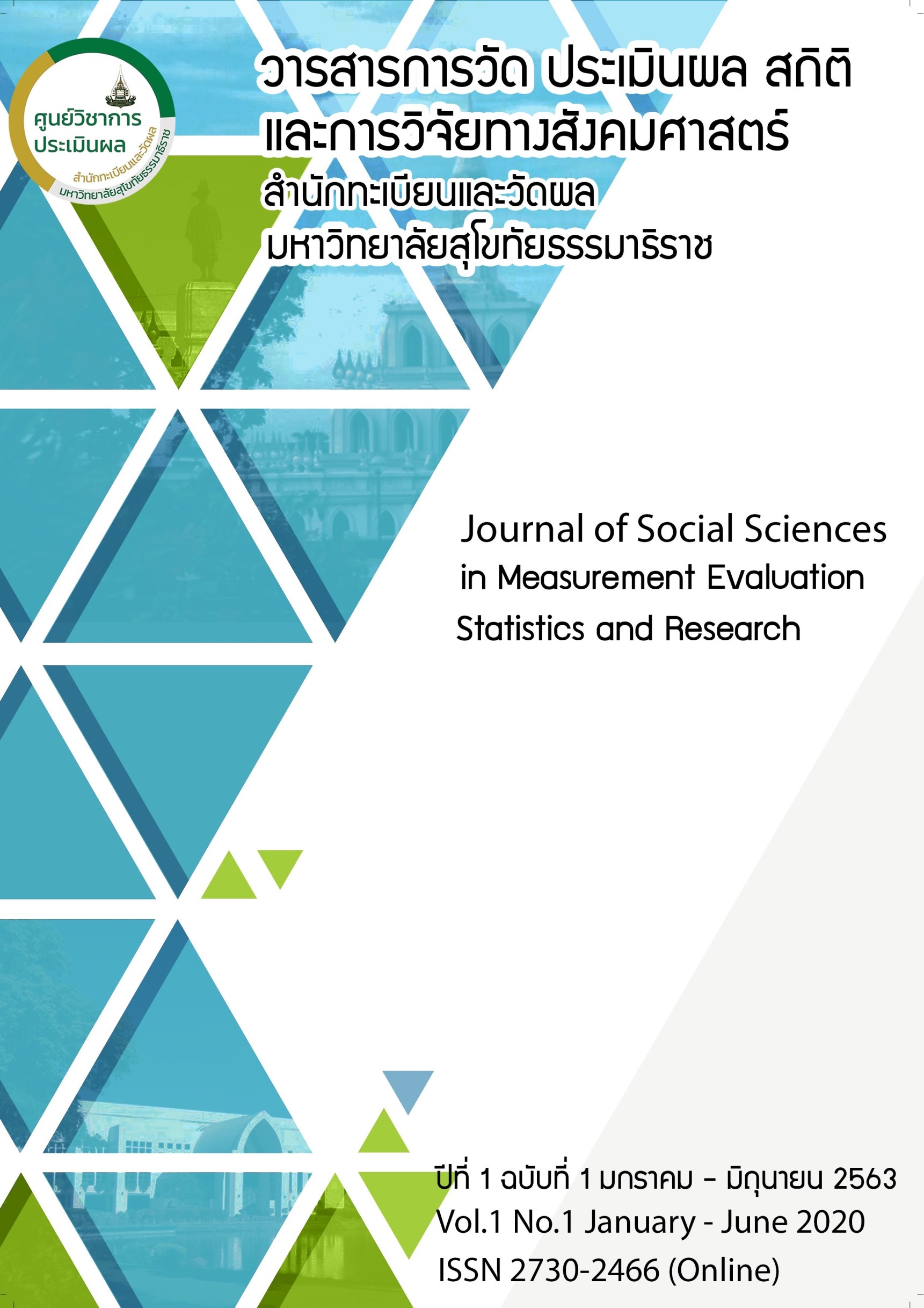หลักการวิเคราะห์โมเดลสมการโครงสร้างพหุระดับโดยใช้ขนาดตัวอย่างและวิธีการประมาณค่าที่เหมาะสม
Main Article Content
บทคัดย่อ
การวิเคราะห์โมเดลสมการโครงสร้างพหุระดับเป็นเทคนิคการวิเคราะห์ทางสถิติขั้นสูงที่เกิดจากการบูรณาการแนวคิดการวิเคราะห์โมเดลสมการโครงสร้างกับการวิเคราะห์พหุระดับ เพื่อศึกษาอิทธิพลของตัวแปรทำนายหลายระดับที่มีต่อตัวแปรตาม และสามารถศึกษาปฏิสัมพันธ์ข้ามระดับได้ ทำให้มีความครอบคลุมและลึกซึ้งกว่าสถิติวิเคราะห์แบบประเพณีนิยม และช่วยแก้ไขข้อจำกัดในการวิเคราะห์ของโมเดลสมการโครงสร้างและการวิเคราะห์พหุระดับได้ การเลือกใช้สถิติควรคำนึงถึงข้อตกลงเบื้องต้นทางสถิติ การกำหนดขนาดตัวอย่างที่เหมาะสมโดยพิจารณาขนาดตัวอย่างระดับมหภาคหรือระดับกลุ่มเป็นอันดับแรก โดยขนาดตัวอย่างระดับกลุ่มสูงสุดในการวิเคราะห์ควรมีจำนวนมากกว่า 30 กลุ่มขึ้นไป สำหรับขนาดตัวอย่างระดับจุลภาคหรือระดับบุคคลที่เหมาะสมควรมีขนาดตัวอย่างเท่ากับ 10-20 เท่าของจำนวนพารามิเตอร์ สำหรับการประมาณค่าพารามิเตอร์ด้วยวิธีความเป็นไปได้สูงสุด (ML) และวิธีความเป็นไปได้สูงสุดแบบให้สารสนเทศเต็ม (FIML) ใช้ในกรณีที่ขนาดตัวอย่างแต่ละกลุ่มเท่ากัน และข้อมูลมีการแจกแจงแบบปกติ ส่วนการประมาณค่าพารามิเตอร์ด้วยวิธีกึ่งความเป็นไปได้สูงสุดของ Muthen (MUML) วิธีความเป็นไปได้สูงสุดบางส่วน (PML) และวิธีความเป็นไปได้สูงสุดด้วยค่าความคลาดเคลื่อนมาตรฐานที่แกร่งและไคสแควร์ (MLR) ใช้ในกรณีจำนวนหน่วยตัวอย่างในแต่ละกลุ่มไม่เท่ากัน และข้อมูลมีการแจกแจงที่ไม่เป็นโค้งปกติ ทั้งนี้ถ้ากลุ่มตัวอย่างมีขนาดใหญ่เพียงพอการประมาณค่าพารามิเตอร์ด้วยวิธี ML และวิธี MUML จะให้ค่าที่ใกล้เคียงกัน
Article Details

อนุญาตภายใต้เงื่อนไข Creative Commons Attribution-NonCommercial-NoDerivatives 4.0 International License.
ข้อความและบทความในวารสารการวัด ประเมินผล สถิติ และการวิจัยทางสังคมศาสตร์ เป็นแนวคิดของผู้เขียน มิใช่ความคิดเห็นของกองบรรณาธิการวารสาร จึงมิใช่ความรับผิดชอบของวารสารการวัด ประเมินผล สถิติ และการวิจัยทางสังคมศาสตร์ บทความในวารสารต้องไม่เคยตีพิมพ์ที่ใดมาก่อน และสงวนสิทธิ์ตามกฎหมายไทย การจะนำไปเผยแพร่ ต้องได้รับอนุญาตเป็นลายลักษณ์อักษรจากกองบรรณาธิการ
เอกสารอ้างอิง
Anderson, J. & Gerbing, D. W. (1984). The effects of sampling errors on convergence, improper solution and goodness of fit indices for maximum likelihood confirmatory factor analysis. Psychometrika, 49, 155-173.
Bentler, P. M. & Yuan, K. H. (1999). Structural equation modelling with small samples: Test statistics. Multivariate Behavioral Research, 34(2), 181–197.
Browne, W., Goldstein, H., Rashbash, J., Plewis, I., Draper, D., & Yang, M. (1998). User's guide to MLwiN. London: Institute of Education.
Bryk, A. S., & Raudenbush, S. W. (1992). Hierarchical linear models newbury park. Calif: Sage Publications.
Diamantopoulos, A. & Siguaw, A. D. (2000). Introducing LISREL: A guide for the uninitiated. London : Sage Publications.
Goldstein, H. (1991). Non-Linear Multilevel Models, with an Application to Discrete Response Data. Biometrika, 78, 45-51.
Goldstein, H. (1995). Multilevel statistical models. London : Edward Arnold.
Hair, J. F., Black, W. C., Babin, B. J., Anderson, R. E., & Tatham, R. L. (1998). Multivariate data analysis, 5(3), 207-219.
Hair, J. F., Black, W.C., Babin, B.J. & Anderson, R. E. (2010). Multivariate data analysis (7th ed.). New York: Pearson.
Heck, R. H. & Thomas, S.L. (2000).An introduction to multilevel modeling techniques. Mahwah, NJ:
Lawrence Erlbaum.
Hox, J. J. & C. J. M. Maas. (2001). The accuracy of multilevel structural equation modeling with pseudobalanced groups and small samples. Structural Equation Modeling, 8(2), 157-174.
Hox, J. J. & C. J. M. Maas. (2004). Robustness issues in multilevel regression analysis. Statistica Neerlandica, 18(2), 127–137.
Hox, J. J. & C. J. M. Maas. (2005). Sufficient sample sizes for multilevel modeling. Methodology, 1(3), 86–92.
Hox, J. J. (2002). Multilevel analysis: Techniques and applications. Mahwah, NJ: Erlbaum.
Kanjanawasee, Sirichai. (2007). Multi-level analysis (4th ed.). Bangkok: Chulalongkorn University Printing House. (in Thai)
Kanjanawasee, Sirichai. (2011). Multi-level analysis (5th ed.). Bangkok: Chulalongkorn University Printing House. (in Thai)
Lindeman, R. H., Merenda, P. F. & Gold, R. Z. (1980). Introduction to bivariate and multivariate analysis. Glenview, Illinois: Scott, Foresman and Company.
Meuleman, B. & Billiet, J. (2009). A Monte Carlo sample size study: how many countries are needed for accurate multilevel SEM?. Survey Research Methods, 3(1), 45-58.
Muthen, B. O. (1994). Multilevel Covariance Structure Analysis. Sociological Methods and Research, 22(1), 376-398.
Muthen, B. O. (2011). Applications of causally defined direct and indirect effects in mediation analysis using SEM in Mplus. Retrieved from statmodel.com/download/causalmediation.pdf
Muthen, L. K. & Muthen, B. O. (1998). Mplus technical appendices. Los Angeles, CA: Muthen and Muthen.
Muthen, L. K. & Muthen, B. O. (2004). Mplus user’s guide (3rd ed). Los Angeles, CA: Muthen and Muthen.


